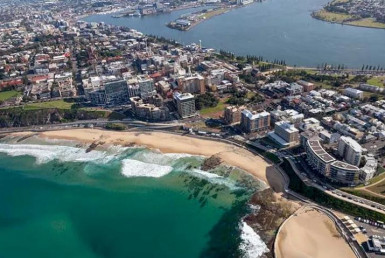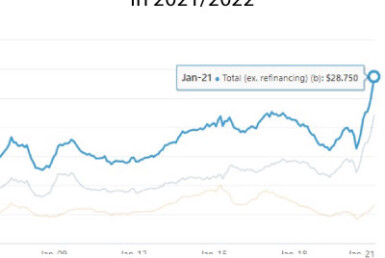Property market forecasts for 2014: Boom, bubble or trouble?
There’s a lot at stake as our property experts gaze into their crystal balls and make some predictions for the coming year.
Terry Ryder, property commentator and founder of hotspotting.com.au, believes the 2014 housing market will show “a little bit more sanity” than this year.
“Sydney and Melbourne are experiencing an auction frenzy, which occurs every three or four years, but things will settle down a bit,” he said. “Next year there will be 5%-10% growth in those cities but it will be more evenly spread across the middle and outer-ring suburbs.”
Ryder predicts the big improver will be Brisbane “which is only just starting to gather momentum”. Improvements will be shared across the board. “Brisbane is behind Sydney and Melbourne after being adversely affected by the devastating floods of 2011 and the job losses experienced by 1,500 public servants after the election of the Newman government in March 2012.
“Brisbane is only just now starting to take off and I see much stronger growth there – perhaps over 10%.”
Ryder predicts Perth’s “solid year” – it was growth leader early in 2013 before being overtaken by Sydney – would ensure it carried momentum, especially into the more affordable areas, in 2014.
He said Darwin had “quietened down” after a flying start fuelled by the $34 billion Ichthys liquefied natural gas project off Western Australia. The 820 kilometres pipeline through Darwin has generated jobs and, consequently, the interest of investors and home buyers. The fact that this growth has already happened will mean a more moderate 2014 for the city.
Adelaide, he said, would show moderate growth next year of around 5%, while Hobart – “technically in recession”– will need government input to maximise its opportunities.
Ryder predicts savage job cuts of 10,000 to 15,000 by the Abbott government and an apartment oversupply will have Canberra “struggling” into the New Year.
He believes the next interest rate move will be up – but not possibly before at least the middle of next year – and that a heated Sydney property market is not reason enough to put the brakes on the economy as a whole.
He described a 7% increase in property values overall – after two years of zero growth – as “moderate” and not justifying any dampening tactic by the RBA. “Affordability is the best it’s been in 10 years so there’s no need to put on the brakes in 2014 – even though a lot can happen in six months.”
Regions should do well in 2014, he predicts, especially those with input from resources, such as Narrabrai and Dubbo in NSW, Myles and Rockhampton in Queensland, and Port Lincoln in South Australia. A regional growth leader will be Cairns in Far North Queensland which is making a comeback. Ballarat and Bendigo in Victoria will show growth, boosted by high infrastructure spending and regional rail links.
No-go areas, Ryder warns, are Melbourne’s Docklands, Southbank and CBD, where oversupply has stymied the apartment market. Likewise, oversupply will affect the Queensland coal port of Gladstone, he says. Ryder is not enamoured with regional city Mackay nor tourism hotspot, the Gold Coast. “Stay away from the speculative market,” he warns, “and buy in ‘real’ suburbs with real housing where people have jobs and buy houses to live in. Sales momentum in south-east Queensland is inland – not on the coast.”
Peter Wargent, co-founder of Allen Wargent property buyers in London and Sydney, is a best-selling author and blogger. He said:
“Our base case sees a number of key variables which will represent headwinds for the property markets in 2014.
“With the unemployment rate still in a moderate uptrend and mining capital investment set to fall, it is likely to be a year of sub-trend economic growth for Australia, and, consequently, we are tending towards a more subdued overall view than you will see elsewhere.
“The RBA has yet to see the material uplift in dwelling construction it had hoped for, so we are expecting to see interest rates remaining historically low, and the next adjustment may yet still be down.”
Sydney is the clear standout, he said. There are likely challenges ahead for Canberra, but Brisbane could be the star.
Wargent’s property price predictions:
- Canberra -1% to -4%
- Hobart -1% to 2%
- Perth 0% to 3%
- Adelaide 0% to 3%
- Brisbane 2% to 5%
- Melbourne 2% to 5%
- Sydney 6% to 9%
The Melbourne property market in 2014 is likely to maintain – and even build – on the momentum of 2013, according to Monique Sasson, founder of Wakelin Property Advisory.
“2013 was a year of recovery with the values of many properties recouping their losses since the last peak in 2010,” she said.
“We anticipate this trend to continue, and feel the momentum of the past 12 months should carry the Melbourne market upwards in the first half of 2014.
“There will be many Super Saturdays – weekends with a thousand-plus auctions – throughout the autumn of 2014. Nevertheless, robust demand should soak up this supply and see auction clearance rates remain at around 70%.
“In a typical year, the first serious auction weekends don’t occur until mid-or-late February. But the auction season may well open a little earlier than usual in 2014 and we may see a lot of deals in the private treaty market as early as January.
“The greater unknown is what will happen in the second half of 2014. In large part, the trajectory of the property market will be determined by the Reserve Bank’s attitude to setting monetary policy.
“It may well be the case that the RBA decides to leave interest rates steady throughout most of 2014. If that scenario eventuates, then expect to see Melbourne price growth in 2014 to be strong, and potentially reaching double-digits.
“I doubt the Reserve Bank will be entirely comfortable with this potential outcome – especially if there is a similar result in Sydney.
“Consequently, there is a reasonable likelihood of a modest tightening in monetary policy – perhaps 25 or 50 basis points – from around the middle 2014, or even earlier. This would dampen capital growth in the second half of the year and possibly see a retracting back of some of the earlier 2014 growth.
“Should the Reserve Bank cut rates again, then I expect this will accelerate capital growth in 2014. However, in our view, another rate cut seems unlikely and unwise. As well as fuelling price inflation, cutting rates to 2.25% or lower leaves the Reserve Bank with little in the way of monetary ammunition to respond to any unexpected shocks: such as the banking crisis of 2008.”



